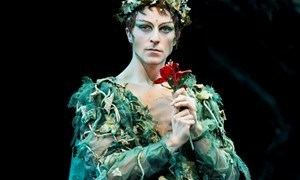 | ||
Premiere 2 April 1964Royal Opera House, London Design Henry Bardon and David Walker | ||
American ballet theatre the dream
The Dream is a one-act ballet adapted from Shakespeare's A Midsummer Night's Dream, with choreography by Frederick Ashton to music by Mendelssohn arranged by John Lanchbery. It was premiered by The Royal Ballet at the Royal Opera House, Covent Garden on 2 April 1964 in a triple bill with Kenneth MacMillan's Images of Love and Robert Helpmann's Hamlet.
Contents
- American ballet theatre the dream
- The dream rehearsal the royal ballet
- Background
- Plot
- Cast
- Critical reception
- Revivals
- References
The dream rehearsal the royal ballet
Background
The ballet was presented to mark the 400th anniversary of Shakespeare's birth. Ashton drastically trimmed Shakespeare's plot, discarding Theseus and Hippolyta and the play-within-a-play, Pyramus and Thisbe. The focus of the ballet is on the fairies and the four lovers from Athens lost in the wood. Lanchbery adapted the overture and incidental music Mendelssohn had written for the play in 1826 and 1842. Ashton and his designers, Henry Bardon and David Walker, set the action in or about the 1840s.
Plot
Four young Athenians, Hermia and Lysander and Helena and Demetrius, are in romantic turmoil. Hermia loves Lysander but her father insists that she must marry Demetrius. The latter has switched his love from Helena to Hermia; Hermia is unmoved and Helena is distraught. Hermia and Lysander escape from Athens, with Demetrius pursuing them, and himself pursued by Helena.
In the forest outside Athens Oberon, king of the fairies, and his queen, Titania, have quarrelled because she refuses to give him her Indian changeling boy as an attendant. Oberon seeks to punish Titania's defiance; he sends his servant, the mischievous fairy Puck, to find a flower called "love-in-idleness". The juice from this flower, if squeezed on a sleeping person's eyelids, makes the victim fall in love with the first living thing seen on awakening. Oberon intends to humiliate Titania by making her fall in love with some monster of the forest.
Into the forest come a group of workmen, the "rude mechanicals". One of them, Nick Bottom, is isolated from his colleagues, and Puck casts a spell to give him the head of a donkey. Oberon squeezes the flower on the eyelids of the sleeping Titania, who, on waking, sees the transformed Bottom and falls madly for him.
Oberon takes an interest in the Athenians, and instructs Puck to use the juice of the flower to make Demetrius fall once more for his former love, Helena, leaving both couples happy. As Puck does not know which of the lovers is which he squeezes the flower over the wrong eyelids, causing further complications as to who loves whom; Oberon eventually resolves matters so that all four lovers are with the right partner, and lifts the spell from Titania, with whom he is reconciled.
Cast
Critical reception
From the outset the piece received good reviews. Both The Times and The Observer noted that the men's roles were particularly strong. In the latter, Alexander Bland called the piece "the first Ashton ballet to be slanted heavily in favour of the men". When the ballet was staged in New York in 2002, the critic Mary Cargill wrote of the Victorian setting:
For once, this time-shifting cliché works, because Ashton used the period's fantasies to create his magical ballet, not the period's realities. He did not choreograph Oberon as a top-hatted industrialist and Titania as his bouncy, bourgeois wife, as so many dreary, unimaginative productions of the play would have it, but modeled them on early Victorian fantasies. Ashton's choreography for the corps is an elegant and witty commentary on the period, with quick and silvery movements, and a soft, flowing upper body, with delicate echoes of the Romantic style (at one point Titania's four attendants strike the famous pose from the Pas de Quatre of the old lithographs, a beautifully designed picture in itself, and an extra joy for those who know their ballet history). Ashton distilled the action of the play to focus on the quarrels between Titania and Oberon, and between the lovers, ending in a magical reconciliation. His basic structure is flawless; the story takes place in a unified set, with the action flowing so smoothly that the dramatic skill involved is hidden.
Revivals
Ashton's ballet was given by the Royal Ballet's touring company in the 1960s and 70s, with scenery and costumes designed by Peter Farmer. A new production, with Ashton's choreography reproduced under the direction of Anthony Dowell, was given at Covent Garden on 6 June 1986.
Among other productions, Ashton's ballet has been given by the Australian Ballet (1969); the Royal Swedish Ballet (1975); the Dutch National Ballet (1977); the National Ballet of Canada (1977); and American Ballet Theatre (2002). A performance by American Ballet Theatre at the Orange County Performing Arts Center in Costa Mesa, California, was videotaped in July 2003 and is available on a Kultur DVD. It stars Ethan Stiefel as Oberon, Alessandra Ferri as Titania, and Herman Cornejo in a defining performance as Puck.
